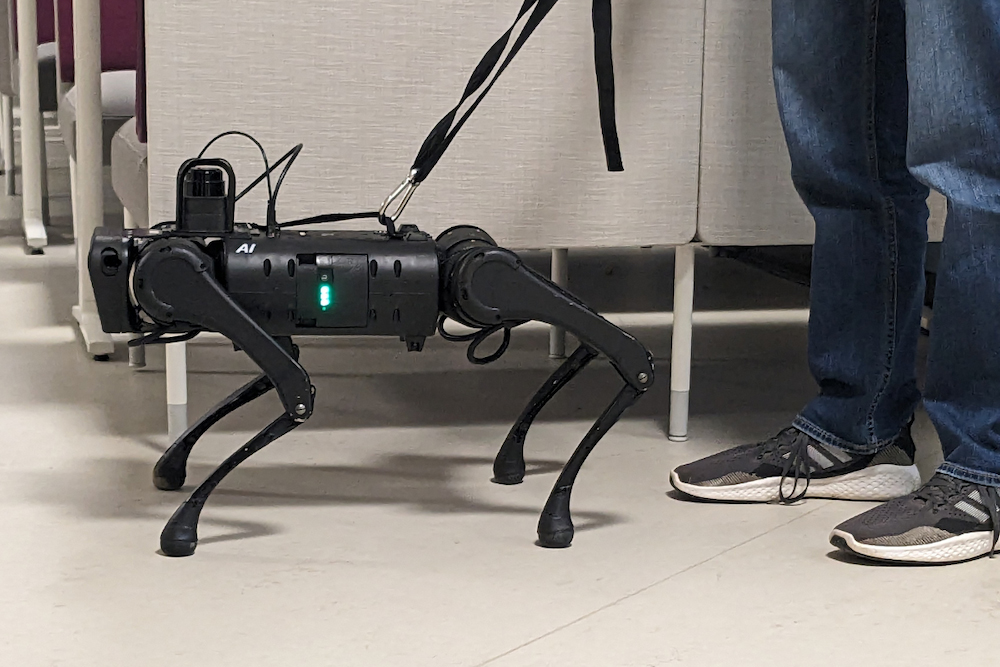Robotics Meets Accessibility: Binghamton Engineers Program Guide Robot for the Visually Impaired

When technology outpaced human skills, Binghamton University’s pioneering engineers built helpful robots. Assistant Professor Shiqi Zhang and his colleagues painstakingly constructed a robotic guide dog for the blind. This intelligent automaton that responds to leash pulls transforms accessibility. It will enhance the availability of guide dogs and provide the blind a more affordable option. This robotic companion reflects quadruped technology and researchers’ commitment to inclusion and independence as it leaves the lab and into ordinary life.
Engineering a Visionary Companion: The Robotic Guide Dog Initiative
A robotic guide dog is being developed by a team at Binghamton University under the direction of Associate Professor Shiqi Zhang under the name “Engineering a Visionary Companion.” This endeavor attempts to rectify the circumstance in which a minority of individuals with visual impairments are able to afford guide canines and endure extensive training. Zhang, junior Eisuke Hirota, PhD candidate David DeFazio, and Zhang collaborated to create a robotic guide dog that reacts to tether tugs. The purpose of this robotic companion is to enhance the autonomy of individuals with visual impairments and showcase the capacity of robotics to solve intricate human problems.
The Mechanics of Guidance: How the Robot Responds to Human Input
Central to this system is an innovative leash-tugging interface, a result of Binghamton University’s year-long research and application of reinforcement learning techniques. This interface acts as a communication bridge between the user and the robot, allowing for simple, intuitive commands. A tug can signal the robot to turn at a hallway intersection, an elegant solution that mirrors the traditional interaction between a guide dog and its handler. The robotic guide dog’s ability to navigate indoor environments, avoid obstacles, and comprehend user guidance within mere hours of training signifies a remarkable leap in assistive technology, promising enhanced mobility for the visually impaired.
Beyond the Prototype: Future Enhancements and Capabilities
Because the prototype demonstrates the promise of assistive robotic technology, the team is contemplating future upgrades. A natural language interface will allow for more complex and nuanced robot-user interactions, transforming simple instructions into conversational exchanges. The development of ‘intelligent disobedience‘ allows the robot to override commands in hazardous situations such as traffic. These technologies are being developed in close collaboration with the visually impaired community in order to address their real-world needs. This ongoing dialogue with possible end-users ensures that the transition from a functional prototype to a fully-fledged assistive equipment will lead to a future in which robotic guide dogs are required for visually impaired persons.
Collaboration for Inclusivity: Working with the Visually Impaired Community
The Binghamton University team has sought feedback from those who might gain the most from their efforts. Engineers are adapting the device to the demands of visually impaired users by collaborating with the Syracuse section of the National Federation of the Blind. Researchers require this collaboration to get critical lived experience in order to enhance the design and operation of the robot. From identifying surface drop-offs to negotiating tough circumstances, community feedback is making the robot more accessible. This collaboration promotes inclusiveness and collaboratively developing technologically advanced solutions to address the needs of the visually impaired.
The Binghamton University team’s robotic guide dog research, a beacon of assistive technology development, brings this narrative of invention and teamwork to a close. This concept blends artificial intelligence and human touch to give visually impaired people more autonomy. This technology will transform accessibility via compassionate design and a commitment to diversity. It’s an example of human ingenuity and collaboration, pointing to a future in which visually impaired individuals might travel the world with unprecedented freedom and confidence, aided by a robotic companion.